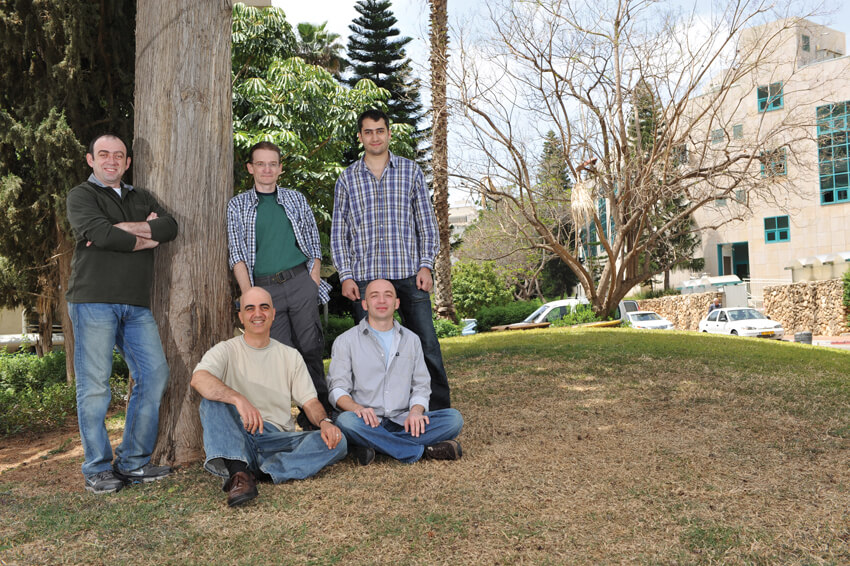Scientists at the Weizmann Institute have developed a new type of chemistry, based on interactions between molecules in water, which may yield innovative materials that are resistant to pressure but also exhibit flexibility - a combination impossible in most materials created by the usual methods

Some mothers prefer to give birth in water. It seems that there is something, in an aquatic environment, that significantly changes the sensations and results, and not by chance - humans, like any other living creature, are mainly composed of water, and the importance of water in biological systems is well known. Also, a new type of chemistry, based on interactions between molecules in water, may yield innovative materials that are resistant to pressure but also show flexibility - a combination that is impossible in most materials created by the usual methods. Dr. Boris Rivchinsky and the members of the research group he heads, in the Department of Organic Chemistry in the Faculty of Chemistry at the Weizmann Institute of Science, recently applied this original approach to create a filter for nanoparticles, which not only makes the process of sorting particles by size simpler, but also Disassembles for cleaning and can be easily recycled. Their findings were recently published in the scientific journal Nature Nanotechnology.
Almost all useful materials produced today are based on strong and irreversible chemical bonds, called covalent bonds. These connections - which can be found, among other things, in polymers, which form the basis of all plastic materials - give the materials strength, but in normal situations they cannot be changed easily: their production requires complex processing, and it is difficult to process them. In contrast to this situation, so-called "supra-molecular" systems connect through non-covalent interactions. Supramolecular systems are capable of self-assembly, and are able to adjust themselves - sometimes, for example, they are able to repair themselves - and therefore simply produce them and recycle them. But, so far, the flexibility advantage of these systems has cost them in strength; That is, at a relative disadvantage of the strength attribute.
Dr. Rivchinsky and the members of his group, including Dr. Haim Weissman, and research students Elisha Krieg and Alya Shirman, together with Dr. Eyal Shimoni from the Department of Chemical Research Infrastructures, investigate the non-covalent bonds between molecules, known as "hydrophobic bonds". Hydrophobic molecules are "water haters": when you put them in water, they form bonds, similar to oil drops that merge. Analysis of the chemical forces at work in these connections suggests that the hydrophobic bonds may be relatively strong, but they are also tunable, environmentally friendly, and cheap to produce. Are these bonds strong enough to be used in the production of new materials that will compete with existing materials with covalent bonds?
Supramolecular systems are good candidates for special applications such as filters for nanoparticles. The existing filters - whose purpose is to sort particles whose diameter does not exceed several billionths of a meter - are expensive, difficult to use, and they clog and break easily. A filter that could be recycled - meaning that the chemical bonds it forms with the material are broken and reattached - could have overcome these problems.
The scientists created molecules with a large hydrophobic component, dissolved them in water, and poured the solution onto a standard filter material with large holes. Instead of passing through the filter material, the molecules were linked and formed a three-dimensional network, perforated with uniform holes several nanometers in size.
It turned out that the network they created serves as an excellent filter for nanoparticles. When the scientists passed a solution containing gold nanoparticles through the mesh, only the particles smaller than five nanometers (which is a critical threshold for many applications) progressed past the supramolecular membrane. When the scientists dissolved the hydrophobic bonds with ethanol, the nanoparticles could be collected and used in the filter again. The scientists repeated the process over and over, and discovered that it is possible to melt and create the filter mesh numerous times, without any harm to its efficiency and capabilities.
Later, the scientists wanted to check whether the network could be more selective and accurate in sorting the particles. For this they created a slightly thicker XNUMXD structure. After running the nanoparticle solution through it, they examined the mesh under an electron microscope. As expected, the smaller particles penetrated deeper into the material, while the larger particles "stuck" closer to the surface - in a way that made it possible to easily separate the different sizes.
Dr. Rivchinsky believes that after additional research is included, the networks for filtering nanoparticles may be effective and green alternatives to the methods in use today. It is possible that the method can also be used to sort biological molecules such as proteins and DNA. "This method may be a cheap and easy-to-use tool, with almost no waste of material. But the best thing is that we presented a completely new application for non-covalent bonds: we showed that they can be strong and reversible at the same time, and form a good basis for new materials that are more efficient and greener than existing materials."
The "Yade" company, which promotes industrial applications based on the inventions of Weizmann Institute of Science scientists, has filed a patent application for these networks.
In praise of rationality
In his spare time, Boris Rybchinsky usually reads historical reference books, and one of his favorite books, to which he returns again and again, is "A History of Western Philosophy" (A History of Western Philosophy) by the philosopher and mathematician Bertrand Russell. "This is an important and interesting book, which, along with a historical overview - which follows the development of Western thought - describes a rational versus an irrational world view. This is a topical book for every scientist. The writer Borges said that this is the only book he would consider taking with him to a desert island, and I highly recommend it."

2 תגובות
Very nice, keep innovating!